QuickLinks:
6600, 6601, 6602, 6603, 6604, 6605, 6606, 6607, 6608, 6609, 6610, 6611, 6612, 6613, 6614, 6615, 6616,
6617, 6618, 6619, 6620, 6621, 6622, 6623, 6624, 6625, 6626, 6627, 6628, 6629, 6630, 6631, 6632, 6633,
6634, 6635, 6636, 6637, 6638, 6639, 6640, 6641, 6642, 6643, 6644, 6645, 6646, 6647, 6648, 6649
Page last updated June 28, 2023
Updating 6623, 6638
(Need to update everything; last update was prior to recent database updates)
Updated distance modulus estimates for 6641
WORKING 6608-6609: Rewriting text (serious problems here)
Added Dreyer NGC entries (what about IC, IC2, notes, errata, 1912?)
NGC 6600 (= NGC 6599 = PGC 61655)
Discovered (Jun 6, 1864) by Albert Marth (and later listed as NGC 6600)
Discovered (Jul 27, 1880) by Édouard Stephan (and later listed as NGC 6599)
A 13th-magnitude lenticular galaxy (type S0?) in Hercules (RA 18 15 42.9, Dec +24 54 47)
Historical Identification: Per Dreyer, NGC 6000 (= GC 5907, Marth #374, 1860 RA 18 09 59, NPD 65 01) is "faint, very small, stellar".
Physical Information: Given the duplicate listing, see NGC 6599 for anything else.
NGC 6601 (= PGC 61533)
Discovered (Aug 4, 1883) by Lewis Swift
Also observed (date?) by Guillaume Bigourdan
A 15th-magnitude lenticular galaxy (type E/S0?) in Draco (RA 18 11 44.2, Dec +61 27 11)
Historical Identification: Per Dreyer, NGC 6601 (Swift list I (#90), 1860 RA 18 10 05, NPD 28 35.1) is "extremely faint, pretty small, round". The second IC lists a corrected RA (per Bigourdan) of 18 10 48.
Physical Information: Apparent size 0.5 by 0.3? arcmin.
NGC 6602 (= PGC 61674)
Discovered (Jul 1, 1886) by Guillaume Bigourdan
A 14th-magnitude spiral galaxy (type SB??) in Hercules (RA 18 16 34.2, Dec +25 02 37)
Historical Identification: Per Dreyer, NGC 6602 (Bigourdan (list II #83), 1860 RA 18 10 10, NPD 65 00) is "a cluster, very small, stars faint, 30 arcsec (wide), nebulous?"
Physical Information: Apparent size 1.0 by 0.7? arcmin.
NGC 6603 (= OCL 36)
In region observed (Jun 20, 1764) by Charles Messier (and recorded as M24)
Discovered (Jul 15, 1830) by John Herschel
An 11th-magnitude open cluster (type I1r) in Sagittarius (RA 18 18 24.0, Dec -18 24 24)
Historical Identification: Per Dreyer, NGC 6603 (= GC 4397 = JH 2004, M 24, 1860 RA 18 10 14, NPD 108 28.1) is "a remarkable object, a cluster, very rich, very much compressed, round, stars from 15th magnitude (in the Milky Way)".
Discovery Notes: Though Dreyer lists this as M24, that is a (much larger) star cloud and not the cluster recorded by Herschel.
Physical Information: Apparent size 4.0? arcmin.
NGC 6604 (= OCL 56)
Discovered (Jul 15, 1784) by William Herschel
Also observed (date?) by John Herschel
A 7th-magnitude open cluster (type I3p) in Serpens (RA 18 18 06.0, Dec -12 13 00)
Historical Identification: Per Dreyer, NGC 6604 (= GC 4398 = JH 3740 = WH VIII 15, 1860 RA 18 10 14, NPD 102 17.2) is "a cluster, a little rich, a little compressed".
Physical Information: Apparent size 6? arcmin.
NGC 6605 (= OCL 47)
Discovered (Jul 31, 1826) by John Herschel
A 6th-magnitude open cluster in Serpens (RA 18 16 24.0, Dec -15 00 00)
Historical Identification: Per Dreyer, NGC 6605 (= GC 4399 = JH 2005, 1860 RA 18 10 21, NPD 104 59.6) is "a cluster, a little rich, a little compressed, stars from 10th to 12th magnitude".
Physical Information: Apparent size 29? arcmin.
NGC 6606 (= PGC 61633)
Discovered (Aug 8, 1883) by Édouard Stephan
A 14th-magnitude spiral galaxy (type Sb?) in Lyra (RA 18 14 41.3, Dec +43 16 07)
Historical Identification: Per Dreyer, NGC 6606 (Stephan list XIII (#88), 1860 RA 18 10 27, NPD 46 46.7) is "very faint, small, round, gradually brighter middle, very faint star involved".
Physical Information: Apparent size 0.9 by 0.7? arcmin.
A Fine Mess: NGC 6607, 6608 and 6609
The following entries represent three of four objects found by Lewis Swift on the same night (Aug 4, 1883), the first of the four being NGC 6601, which (per Bigourdan) had a right ascension 43 seconds of time too small. The errors for the following three do not appear to have been as large, but the confusion about their identity has perplexed modern observers for years, and in my opinion is still perplexing, hence this note, which will be removed or restated if and when I feel I've done the best I can to unravel the tangle. Putting things in their usual GC/NGC order, Swift wrote the following for the three 'following' entries:
list I (#91): 1885 RA 18 10 45, Dec +61 18 05, "extremely faint, pretty small, round, very difficult, 5th of 8"
(#92): 1885 RA 18 11 00, Dec +61 18 15, "very faint, very very small, round, very faint star near, 6th of 8"
(#93): 1885 RA 18 11 05, Dec +61 18 15, "very faint, pretty small, a little extended, faint star near, 7th of 8"
These positions precess to 1860 RA 18 10 29.2, NPD 28 42.3; 1860 RA 18 10 44.2, NPD 28 42.1; and 1860 RA 18 10 49.2, NPD 18 42.1, which exactly agree with Dreyer's NGC positions, so there is no problem with those. The problem is, what (if anything) does each of the positions and descriptions apply to in the sky?
Precssing to the equinox of 2000, the three positions become
For #91, RA 18 11 58.0, Dec +61 19 59
For #92, RA 18 12 13.0, Dec +61 20 12
and For #93, RA 18 12 18.0, Dec +61 20 13

Note that as in the case of NGC 6001, all three positions lie to the west of any possible candidates for Swift's nebulae, though by less than 20 seconds of time, instead of more than 40 seconds of time. Also note that the separation between the box showing the position of #91 lies almost exactly as far from the pair of boxes for #92 and 93 as the distance between the two galaxies on that parallel of declination (namely, 1.35 and 1.39 arcmin respectively), and it becomes essentially certain that #91 represents the galaxy that the pair of eastern boxes straddle, and #92 and 93 represent the galaxy directly to its east. This correspondence is made more certain by the fact that save for a very slight difference in the specified size and shape (small enough that in comparison with other notes by Swift, they are essentially the same) the descriptions of 92 and 93 are essentially identical, including the note about a nearby faint star, which does not correspond to the western galaxy, and as a result, I consider it almost absolutely certain that Howe was correct, and that NGC 6608 and 6609 represent the same galaxy, namely the eastern of the two galaxies on the same line as Swift's positions.
Despite the above, many (in fact almost all) references list the extremely faint, almost linear galaxy well to the south of the line of Swift's observations to be his 6008. I would argue against that on several accounts, one being that although Swift's right ascensions for the night in question were all poor, his declinations appear to have been consistently more or less accurate. Another is that Swift almost certainly could not have seen the faint linear galaxy, as no part of it is bright enough to have caught his attention, as it is far fainter than any of the galaxies in the list of "8" referred to in his descriptions of 91, 92 and 93; and if he had seen it, he would almost certainly have stated that it was considerably extended. Finally, though Steve Gottlieb "momentarily glimpsed [it] as a thin ghostly streak" at 375 power with a 24 inch telescope, he notes that it is "likely too faint to have been picked up by Swift with his 16" refractor [and a power of 132]." On the other hand, Swift claimed to have observed three galaxies here, and there are three galaxies here, so it is hardly surprising that the faint spindle is usually listed as NGC 6608, as it seems odd that Swift would have recorded two different positions, differing by only 5 seconds of time, for the same galaxy on the same night. However, his method of determining the position of his discoveries was awkward and prone to error*, and there are other cases where both he and other observers have made such a blunder.
So, on this basis, what should we do about Swift's #91, 92 and 93? I think the only reasonable solution is to assign NGC 6607 and 6609 as already done below (though I have yet to completely update their entries to current standads), but for NGC 6608 to do some sort of summary similar to the discussion here, state that it is probably a duplicate observation of 6609, but could be an extremely improbable observation of the spindle to its southwest, treat that spindle as a completely separate object, and see what (if anything) future historians decide.
*Swift would observe his nebulae from the top of an observing ladder, then climb down to the bottom, look at the settings on the setting circles to determine the position, then clamber back up again. This caused him to lose some time both from the time required to climb down and up, but also for his eyes to readjust to darkness, which would have made it much harder for him to see the faint spindle. On the other hand, since his low magnification and wide-field viewing-glass allowed him to survey more than half a degree of the sky at a time, he could easily find the same region he'd been observing, re-examine it, then allow the movement of the sky to bring new regions into view. But that also means that he might have, as a result of such an effort, accidentally measured the same object twice. Whereas if he had seen both the eastern galaxy which is almost certainly #93 and NGC 6609 and the faint spindle a few seconds of time and a couple of arcmin to the south at the same time, why didn't he just estimate the separation as part of a single observation, then check his setting circles, and most importantly, noted the relative positions of the two objects in his list I? In other words, although it doesn't make a lot of sense that he should have observed the same galaxy twice in the same observing session, it makes even less sense that he didn't note the relative positions of the spindle and the one that became 6609 in his paper.
Note About Visual Magnitudes: There do not appear to be any visual magnitudes listed in standard references, and although Steinicke provides visual magnitudes they do not seem to agree with the relative brightness of the three galaxies in this region as I see them on various images. I have therefore looked at the range of magnitudes in different wavelength ranges in several references, and at the visual magnitude estimates in Steve Gottlieb's visual examination of the NGC/IC objects. NGC 6609 is a "late-type" relatively reddish object, while 6607 is an "early-type" bluer object, and it appears that in most respects the spindle often (mis?)identified as 6608 is even a little bluer overall, but otherwise similar to 6607 in terms of the difference in brightness at various wavelengths. Taking these factors into account, the visual magnitudes listed by Gottlieb appear to me to be far more like what the galaxies look like in the sky than the values in Steinicke's database; and as a result, though I have added question marks to the values to indicate that they are probably not accurate to a tenth of a magnitude, I believe that they correctly show that 6609 is the brightest of the three, 6607 not much fainter, and the spindle is by far the faintest.
WORKING HERE; primarily updating text
NGC 6607 (= PGC 61550)
Discovered (Aug 4, 1883) by Lewis Swift
Looked for but not found (Jul 1899 - Jun 1900) by Herbert Howe
A magnitude 14.6(?) spiral galaxy (type SAB(rs)c?) in Draco (RA 18 12 14.8, Dec +61 19 59)
Historical Identification: Per Dreyer, NGC 6607 (Swift list I (#91), 1860 RA 18 10 29, NPD 28 42.3) is "extremely faint, pretty small, round, very difficult". The second IC states "Not found by Howe (3 nights)", suggesting a poor position, but the position precesses to RA 18 11 57.8, Dec +61 19 59, only about 2 arcmin due west of the galaxy listed above, and a considerably brighter galaxy (which must be NGC 6608 or 6609, listed by Swift as being 15 and 20 seconds of time to the east) is clearly visible about 19 seconds of time to the east. So the problem is not the position, which is not a bad one for Swift, but the fact that the galaxy is relatively diffuse and hard to see. In any event, the close correspondence of relative positions and descriptions for this and "NGC 6608/9" (which have essentially identical desciptions) make the identification of NGC 6607 as PGC 61550 certain.
Physical Information: Based on a recessional velocity relative to the Cosmic Microwave Background radiation of 6690 km/sec (and H0 = 70 km/sec/Mpc), NGC 6607 is about 310 million light-years away. Given that and its apparent size of about 0.6 by 0.55 arcmin (from the images below), the galaxy is about 55 thousand light-years across.

Above, a 12 arcmin wide DSS image centered on NGC 6007, also showing NGC 6609 and PGC 61556
Below, a 1 arcmin wide DSS image of the galaxy

Below, a 1 arcmin wide AladinLite/PanSTARRS image of the galaxy

WORKING HERE: This entry will only contain historial arguments about identification
For anything about objects identified (or misidentified) as NGC 6608, use the links in the title lines
NGC 6608 (probably = NGC 6609 = PGC 61559,
but perhaps PGC 61556 = PGC 2615431)
Recorded (Aug 4, 1883) by Lewis Swift
Looked for but not found (Jul 1899 - Jun 1900) by Herbert Howe
Probably a magnitude 14.5 lenticular galaxy (type S0?) in Draco (RA 18 12 29.0, Dec +61 19 56)
Historical Identification: Per Dreyer, NGC 6608 (Swift list I (#92), 1860 RA 18 10 44, NPD 28 42.1) is "very faint, extremely small, round, very faint star near". The second IC states "Not found by Howe (2 nights); = 6609?". The position precesses to RA 18 12 12.8, Dec +61 20 14, almost dead center on PGC 61550 (= NGC 6607), which does not fit the description, and about 2.5 arcmin nearly due west of the galaxy listed above, which perfectly matches the description. Under normal circumstances the nearly identical positional error (and the correspondingly good relative position) of the two galaxies would be considered certain proof of their identity; but there is a problem, in that Swift lists two galaxies to the east of NGC 6607, separated by only 5 seconds of time, and there is only one galaxy there. As suggested by the second IC note, the solution is probably that the "two galaxies" are actually a duplicate listing of the same galaxy, but they were recorded on the same night, presumably at nearly the same time, making it hard to understand how Swift could have made such a mistake. For reasons discussed in the Discovery Notes for this entry, a duplicate entry is the most likely scenario, but as noted by Corwin, this is one of the most puzzling problems posed by Swift's observations. Still, in the light of the discussion below, the second IC solution (NGC 6608 being a duplicate observation of NGC 6609) is almost certainly correct, as noted in the title of this entry; however, since there is no way to know what Swift saw on the night in question, it seems best to list that as only the most likely solution, and offer another (albeit less likely) solution in the following entry (for PGC 61556).
Discovery Notes: Five seconds of time west of PGC 61559 and 2 arcmin to the south, there is a third galaxy in the region; and if we ignore the difference between the description of NGC 6608 and the appearance of the third galaxy, it is possible that NGC 6608 is actually that galaxy, with a 2 arcminute error in its NPD. The problem is that PGC 61556, the galaxy to the south, is not considerably brighter than NGC 6607, as the description for NGC 6608 suggests, but even fainter. In fact Steve Gottlieb, in discussing his observations of the region, notes that even NGC 6607 would have been a difficult object for Swift to observe, and the fainter PGC 61556 almost certainly impossible for him to see. In addition, its appearance does not match the description for NGC 6608, and there is no "very faint star near" it, as there is near PGC 61559. Despite these problems, the urge to attach the three NGC entries to three galaxies and the presence of this third galaxy means that for most of the last few decades PGC 61556 has been (almost certainly mis-)identified as NGC 6608 (save for a few unfortunate occasions on which it has been misidentified as NGC 6609, which is a blunder). Given that history, PGC 61556 is discussed in the following entry.
Physical Information: Given the probable duplicate entry, see NGC 6609 for anything else.
PGC 61556 (= PGC 2615431, and perhaps but probably not = NGC 6608)
Probably not an NGC object but listed here because often misidentified as NGC 6608 or 6609
A magnitude 15.6(?) spiral galaxy (type Scd?) in Draco (RA 18 12 29.0, Dec +61 17 54)
Historical Misidentification: See the Discovery Notes for NGC 6608 for a discussion of why PGC 61556 is probably not that object. Its occasional misidentification as NGC 6609 is simply a head-shaking blunder by those who compiled the MCG.
Physical Information: Based on a recessional velocity relative to the Cosmic Microwave Background radiation of 6635 km/sec (and H0 = 70 km/sec/Mpc), PGC 61556 is about 310 million light-years away, in poor agreement with redshift-independent distance estimates of about 375 to 470 million light-years. Using the Hubble Flow distance, its apparent size of about 0.8 by 0.07 arcmin (from the images below) corresponds to about 70 to 75 thousand light-years. The larger distances would yield a physical size of about 100 thousand light-years, give or take 10 or so thousand light-years.

Above, a 1 arcmin wide DSS image of PGC 61556 (see NGC 6608 for a wider view)
Below, a 1 arcmin wide PanSTARRS image of the galaxy

NGC 6609 (= PGC 61559 and probably = NGC 6608)
Discovered (Aug 4, 1883) by Lewis Swift
Also observed (Jul 1899 - Jun 13:20 AM 6/22/20200) by Herbert Howe
A magnitude 14.3(?) lenticular galaxy (type S0?) in Draco (RA 18 12 33.6, Dec +61 19 55)
Historical Identification: Per Dreyer, NGC 6609 (Swift list I (#93), 1860 RA 18 10 49, NPD 28 42.1) is "very faint, pretty small, a little extended, faint star near". In a note about NGC 6608, the second IC states "Not found by Howe (2 nights); = 6609?". (Given the nearly identical positions and descriptions of NGC 6608 and 6609 and the fact that there is only one galaxy in the region that could fit the descriptions, the suggestion of a duplicate entry is almost certainly correct; but as discussed in the Discovery Notes for NGC 6608, that is one of the more puzzling of Swift's observations, and as a result the duplicate entry is only "probably correct", and not "certain".) As noted in the entry for NGC 6608 it is hard to see how Swift could have mistakenly listed two observations for the same galaxy when the observations were made on the same night, presumably at nearly the same time. But the fact that the descriptions are essentially identical and only match one galaxy in the region makes a duplicate entry the only truly reasonable (even if puzzling) solution to the problem. In any event, the position precesses to RA 18 12 17.8, Dec +61 20 15, just east of NGC 6607 and about 1.9 arcmin nearly due west of the galaxy listed above. The descriptions and relative positions of NGC 6607 and 6609 make their identification essentially certain, the only question being whether NGC 6608 is truly a duplicate observation of NGC 6609.
Discovery Notes: As noted in the previous two entries, PGC 61556 is usually (almost certainly mis-)identified as NGC 6608, and even (all too often) misidentified as NGC 6609. There is some rationale for wishing PGC 61556 to be NGC 6608, there being three NGC entries in the region and three galaxies, and even though PGC 61556 is almost certainly too faint for Swift to have seen, and does not in any way match his description of NGC 6608, it makes a tempting even if very unlikely candidate. However, there is absolutely no excuse for misidentifying it as NGC 6609, and that can only be considered a blunder.
Physical Information: Based on a recessional velocity of 8150 km/sec, a straightforward calculation (with H0 = 70 km/sec/Mpc) indicates that NGC 6609 is about 380 million light-years away. However, for objects at such distances we should take into account the expansion of the Universe during the time it took their light to reach us. Doing that shows that the galaxy was about 365 to 370 million light-years away at the time the light by which we see it was emitted, about 370 to 375 million years ago (the difference between the two numbers being due to the expansion of the intervening space during the light-travel time). Given that and its apparent size of about 0.9 by 0.65 arcmin (from the images below), the galaxy is about 95 thousand light-years across.
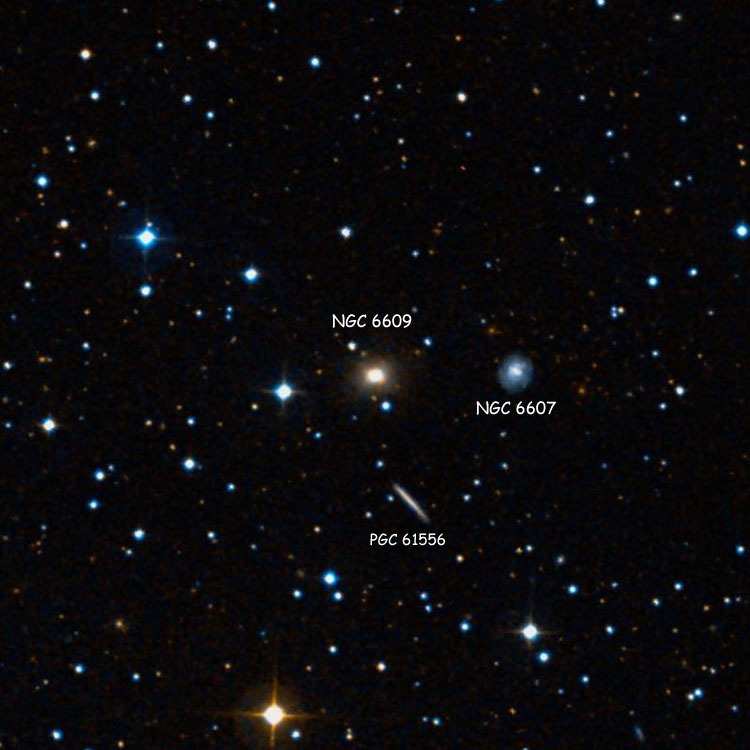
Above, a 12 arcmin wide DSS image centered on NGC 6609, also showing NGC 6607 and PGC 61556
Below, a 1 arcmin wide DSS image of the galaxy

Below, a 1 arcmin wide PanSTARRS image of the galaxy

NGC 6610 (= NGC 6574 = PGC 61536)
Discovered (Jul 9, 1863) by Albert Marth (and later listed as NGC 6574)
Discovered (Jul 13, 1876) by Édouard Stephan (and later listed as NGC 6610)
A 12th-magnitude spiral galaxy (type SBbc?) in Hercules (RA 18 11 51.2, Dec +14 58 54)
Historical Identification: Per Dreyer, NGC 6610 (= GC 53:20 AM 6/22/20208, Stephan list VII (#21), 1860 RA 18 10 56, NPD 75 02.9) is "faint, small, extended, much brighter middle, mottled but not resolved".
Physical Information: Given the duplicate entry, see NGC 6574 for anything else.
NGC 6611 (= M16 = OCL 54), an open cluster in The Eagle Nebula
(associated with IC 4703)
Discovered (1745) by Philippe de Chéseaux
Observed (Jun 3, 1764) by Charles Messier and listed as M16
Rediscovered (date?) by William Herschel
Also observed (date?) by John Herschel
A 6th-magnitude open cluster (type II3mn) in Serpens (RA 18 18 45.0, Dec -13 47 54)
Historical Identification: Per Dreyer, NGC 6611 (= GC 4400 = JH 2006, M 16, 1860 RA 18 10 57, NPD 103 50.0) is "a cluster, at least 100 stars large and small". Dreyer's precessed position is a few seconds east and 1.5 arcmin north of the "standard" position, but in comparison to the size of the cluster the discrepancy is minor; so there is no doubt of the identification. Although de Chéseaux discovered the cluster in the 1740's, his only publication of his discoveries was a report to the French Academy of Sciences which was more or less forgotten until Guillaume Bigourdan published a note about de Cheseaux in 1892; so when Dreyer published the New General Catalog, which was primarily an updating and expansion of John Herschel's General Catalog, he credited John Herschel as the discoverer. Why he didn't credit Messier, or John's father William Herschel, is not obvious at this writing. (Far more to follow...)
Physical Information: The Eagle Nebula and the young star cluster associated with it are about 7000 light-years away, meaning we see them as they were 7000 years ago. But up to the left of the brightest part of the nebula, where the star cluster is centered, is a violently expanding cloud of gas caused by a supernova which took place a few thousand years beforehand. Estimates are that six thousand years ago, high-velocity supernova gases slammed into, compressed and simultaneously tore apart the so-called "Pillars of Creation" near the center of the nebula (though we won't see that until a millennium from now). In the process, most of the clouds of gas and dust visible here would be torn apart, but some of the denser nodules hidden inside the Pillars would be violently compressed to quickly form bright new stars. In fact, in such regions close to half the bright stars formed are the result of such events, and for lower mass stars like our Sun, compression by expanding gases is almost always the cause of their formation.

Above, a ? arcmin wide view of the region near NGC 6611 (click here for a much larger version)
(T.A.Rector (NRAO/AUI/NSF and NOAO/AURA/NSF) and B.A.Wolpa (AURA/NSF), NOAO)
Below, a ? arcmin wide (cropped) view of the image above
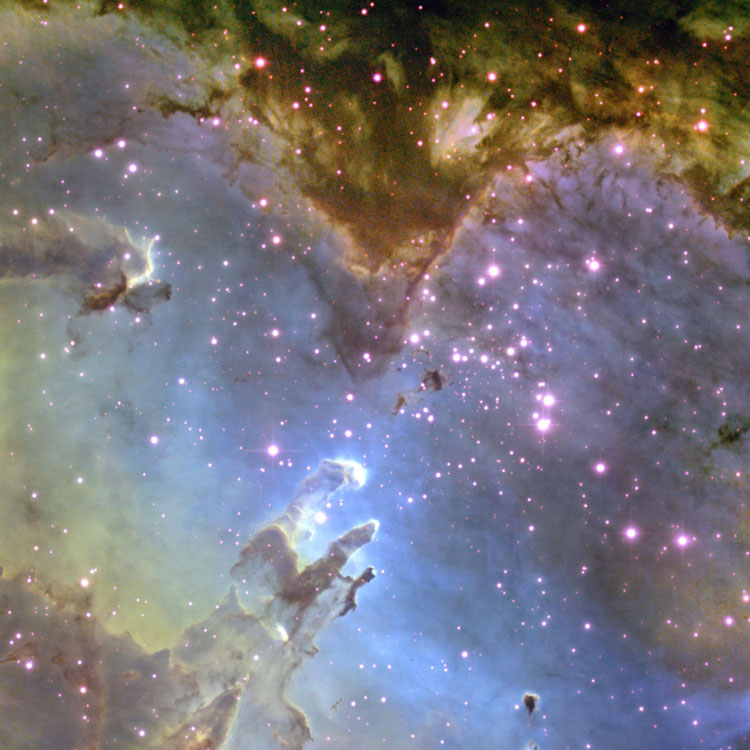
Below, a ? arcmin wide HST image of the "Pillars of Creation", a star-forming region now long-gone
(Image Credits: J. Hester, P. Scowen (ASU), NASA, HST)
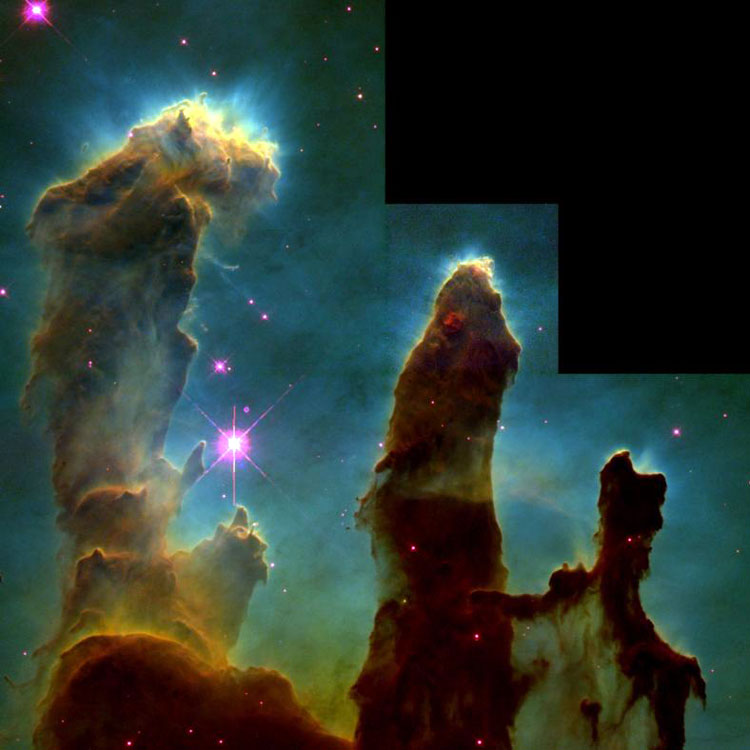
Below, a 2014 update of the image above shows how hot gases are eating away the 'pillars'
(Image Credit NASA/ESA/Hubble Heritage Team (STScI/AURA)/J. Hester, P. Scowen (Arizona State U.))
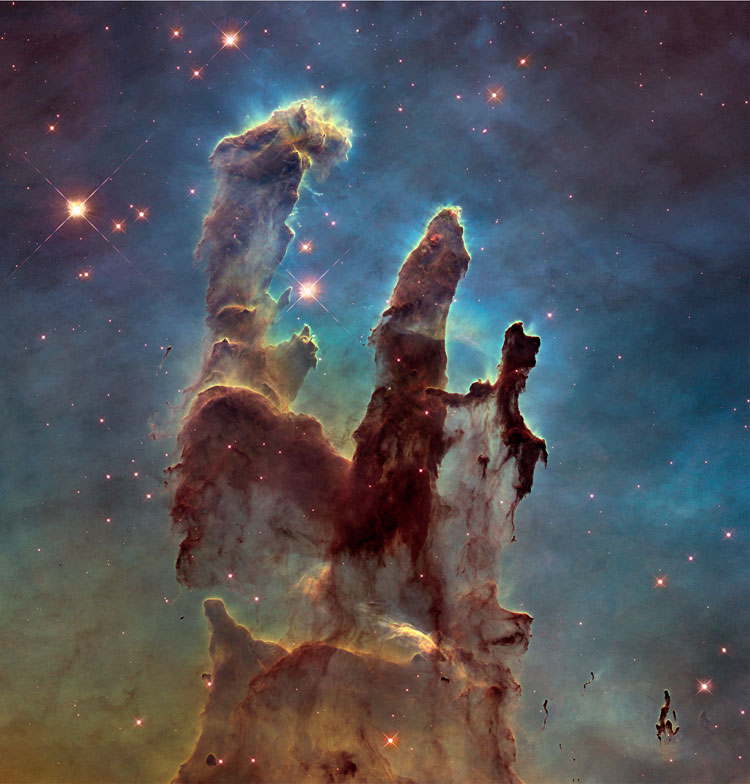
NGC 6612 (= PGC 61665)
Discovered (1886) by Lewis Swift
A 14th-magnitude lenticular galaxy (type E/S0?) in Lyra (RA 18 16 10.8, Dec +36 04 43)
Historical Identification: Per Dreyer, NGC 6612 (Swift list VI (#??), 1860 RA 18 11 05, NPD 53 55.0) is "most extremely faint, extremely small, round, very difficult".
Discovery Notes: This is an object listed by Dreyer as being is Swift's list VI which is not in his published list VI. The reason is that Swift sent Dreyer a pre-publication copy of the paper that contained a number of objects that were inadvertently left out of the published paper. For many of them the omission was corrected by adding them to Swift's list IX, but in this case the error was never corrected, hence the lack of a reference number for the object.
Physical Information: Apparent size 0.45 by 0.45 arcmin.
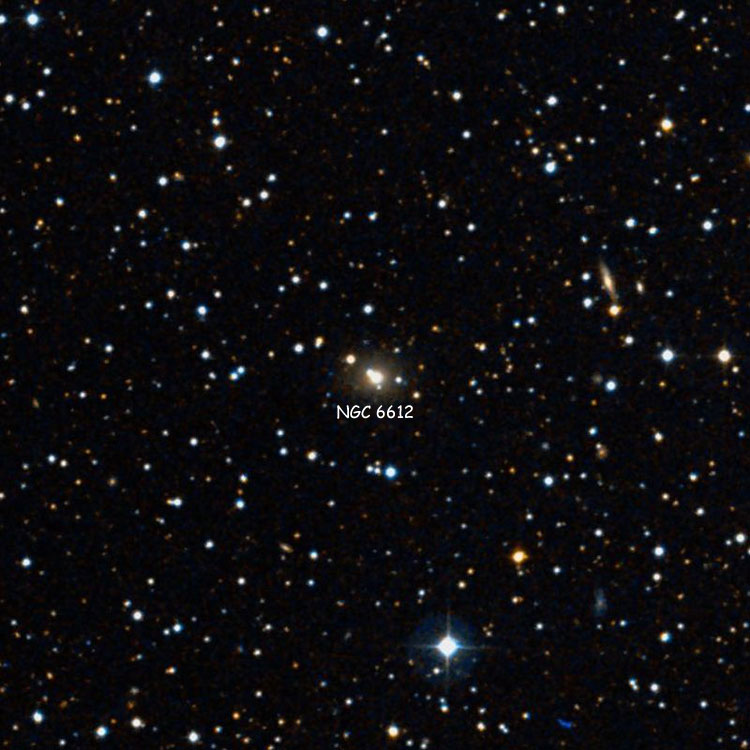
Above, a 12 arcmin wide DSS image centered on NGC 6612
Below, a 0.6 arcmin wide DSS image of the galaxy

NGC 6613 (= M18 = OCL 40)
Discovered (Jun 3, 1764) by Charles Messier (and recorded as M18)
Also observed (date?) by John Herschel
A 7th-magnitude open cluster (type II3pn) in Sagittarius (RA 18 19 58.0, Dec -17 06 06)
Historical Identification: Per Dreyer, NGC 6613 (= GC 4401 = JH 2007, M 18, 1860 RA 18 11 45, NPD 107 11.1) is "a cluster, poor, very little compressed".
Physical Information: NGC 6613 is a loose collection of about 20 stars, spread over a region about 15 to 20 light-years in diameter, four to six thousand light-years from the Sun (its size being based on its estimated distance, and its apparent size of 7.0 arcmin). Its hottest, brightest members are of the relatively 'early' spectral type B3, which means it is probably about 30 million years old. 
Above, a ? arcmin wide image of NGC 6613 (Image Credit: Hillary Mathis, REU program, AURA, NSF, NOAO)
NGC 6614 (= PGC 61852)
Discovered (Jun 20, 1835) by John Herschel
A 13th-magnitude lenticular galaxy (type E/SB0?) in Pavo (RA 18 25 07.3, Dec -63 14 54)
Historical Identification: Per Dreyer, NGC 6614 (= GC 4402 = JH 3741, 1860 RA 18 11 45, NPD 153 17.8) is "very faint, small, round, gradually a very little brighter middle, 9th magnitude star to west".
Physical Information: Apparent size 1.4 by 1.1? arcmin
NGC 6615 (= PGC 61713)
Discovered (Jul 9, 1863) by Albert Marth
A 13th-magnitude lenticular galaxy (type SB0/a?) in Ophiuchus (RA 18 18 33.4, Dec +13 15 55)
Historical Identification: Per Dreyer, NGC 6615 (= GC 5759, Marth #375, 1860 RA 18 12 07, NPD 76 49) is "very faint, very small".
Physical Information: Apparent size 1.3 by 0.9? arcmin
NGC 6616 (= PGC 61693)
Discovered (Jul 14, 1885) by Lewis Swift
Also observed (date?) by Herbert Howe
A 14th-magnitude spiral galaxy (type Sab?) in Hercules (RA 18 17 41.0, Dec +22 14 16)
Historical Identification: Per Dreyer, NGC 6616 (Swift list II (#64), 1860 RA 18 12 12, NPD 67 49.1) is "very faint, extremely small, much extended, 2 faint stars near". The second IC adds (per Howe) "RA is 18 11 47, the 2 stars are 9th to 10th magnitude, one 2 seconds west and 0.6 arcmin south".
Physical Information: Apparent size 1.4 by 0.6? arcmin.
NGC 6617 (= PGC 61613)
Discovered (Jun 14, 1885) by Lewis Swift
A 15th-magnitude spiral galaxy (type Scd?) in Draco (RA 18 14 02.9, Dec +61 19 10)
Historical Identification: Per Dreyer, NGC 6617 (Swift list I (#94), 1860 RA 18 12 24, NPD 28 43.7) is "most extremely faint, pretty large, round, very difficult".
Physical Information: Apparent size 1.1 by 0.7? arcmin
NGC 6618 (= M17 = OCL 44, the Swan, or Omega Nebula)
Discovered (1745) by Phillipe de Cheseaux
Recorded (Jun 3, 1764) by Charles Messier and listed as M17
Also observed (date?) by John Herschel
A 5th-magnitude emission nebula and open cluster in Sagittarius (RA 18 20 47.0, Dec -16 10 18)
Historical Identification: Per Dreyer, NGC 6618 (= GC 4403 = JH 2008, M 17, 1860 RA 18 12 42, NPD 106 13.9) is "a magnificent or otherwise interesting object, bright, extremely large, extremely irregular figure, 2 hooked". Dreyer's precessed position is less than 0.2 arcmin south of the standard position, so the identification is certain. Although de Chéseaux discovered the cluster in the 1740's, his only publication of his discoveries was a report to the French Academy of Sciences which was more or less forgotten until Guillaume Bigourdan published a note about de Cheseaux in 1892; so Messier's discovery was independent.
Physical Information: The brighter parts of the nebula appear somewhat like a bird floating on a body of water, hence the "Swan". The brightest part of the nebula extend over 15 light-years, but fainter clumps of gas cover 40 or more light-years. About three dozen young stars are hidden within the gas and dust of the nebula, which has nearly a thousand solar masses of gas thinly spread over its volume. The Swan is about 5700 light-years from the Sun. Apparent size 20 by 15 arcmin.

Above, a ? arcmin wide image of NGC 6618 (Image Credit Adam Block/NOAO/AURA/NSF/NOAO)
Below, a ? arcmin wide multi-spectral image of the Swan reveals more detail (Image Credit ESO)

Below, a ? arcmin wide image of M17 (Image Credit and © Jim Misti, Misti Mountain Observatory; used by permission)

Below, a ? arcmin wide multi-spectral image reveals features hidden in visible light
(Image Credit ESO/INAF-VST/OmegaCAM. Acknowledgement: OmegaCen/Astro-WISE/Kapteyn Institute)
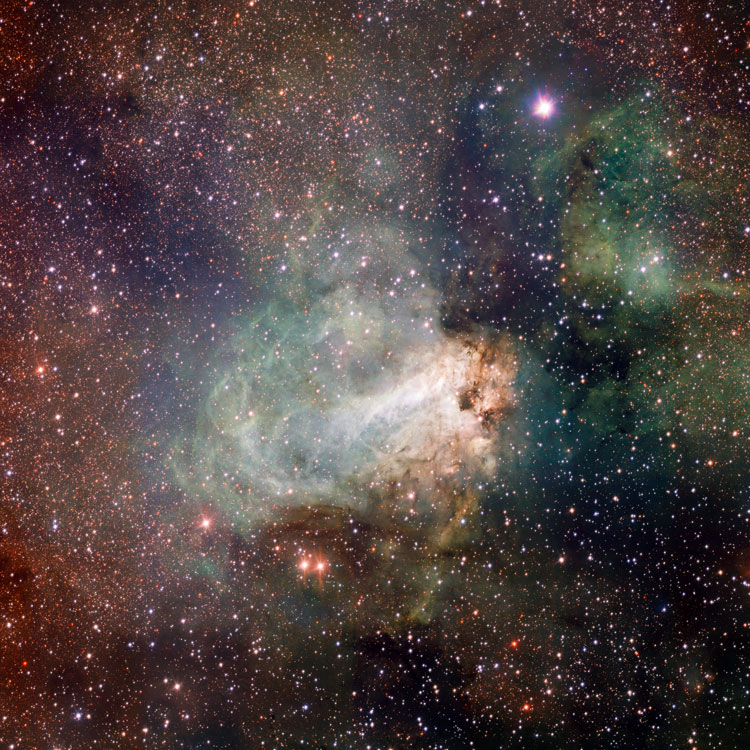
NGC 6619 (= PGC 61721)
Discovered (Jun 6, 1864) by Albert Marth
A 13th-magnitude elliptical galaxy (type E1?) in Hercules (RA 18 18 55.5, Dec +23 39 19)
Historical Identification: Per Dreyer, NGC 6619 (= GC 5910, Marth #376, 1860 RA 18 13 07, NPD 66 25) is "faint, small, extended".
Physical Information: Apparent size 1.2 by 1.1? arcmin
NGC 6620 (= P-K 005-06.1 = "PGC 3517792")
Discovered (Sep 3, 1880) by Edward Pickering
A 13th-magnitude planetary nebula in Sagittarius (RA 18 22 54.2, Dec -26 49 16)
Historical Identification: Per Dreyer, NGC 6620 (Pickering (HN 43), 18 13 08, NPD 116 54) is "a planetary nebula, stellar".
PGC Designation Note: For purposes of completeness, LEDA assigned a PGC designation to this object, even though it isn't a galaxy; however, a search of the database for that designation returns no result, so it is shown in quotes.
Physical Information: Apparent size 0.13? arcmin
NGC 6621 (= PGC 61579, and with NGC 6622 = Arp 81)
Discovered (Jun 2, 1885) by Lewis Swift
A magnitude 15.0 spiral galaxy (type (R)SBa? pec) in Draco (RA 18 12 59.9, Dec +68 21 15)
Historical Identification: Per Dreyer, NGC 6621 (Swift list I (#96) and II (#65?), 1860 RA 18 13 53, NPD 21 43.9) is "pretty faint, pretty small, round, a little brighter middle, southern of 2", the other being NGC 6622. (Note: Swift's positions for I-95/96 and II-66/65 are different, but the descriptions and relative positions are the same, so odds are Dreyer was correct in assuming they are the same objects; however, I will revisit this in a later iteration of this page.)
Warning: Although Dreyer specifies that NGC 6621 is the southern member of the pair of galaxies, most references misidentify it as the northern member, presumably because that is the western member of the pair.
Physical Information: NGC 6621 is obviously colliding and interacting with NGC 6622, which see for images and a detailed discussion of the system.
NGC 6622 (= PGC 61582, and with NGC 6621 = Arp 81)
Discovered (Jun 2, 1885) by Edward Swift
A magnitude 13.6 spiral galaxy (type Sb? pec) in Draco (RA 18 12 55.6, Dec +68 21 47)
Historical Identification: Per Dreyer, NGC 6622 (Swift list I (#95) and II (#66?), 1860 RA 18 13 53, NPD 21 43.7) is "pretty faint, pretty small, round, a little brighter middle, northern of 2", the other being NGC 6621. (Note: Swift's positions for I-95/96 and II-66/65 are different, but the descriptions and relative positions are the same, so odds are Dreyer was correct in assuming they are the same objects; however, I will revisit this in a day or two, so check back then if you really care.)
Warning: Although Dreyer specifies that NGC 6622 is the northern member of the pair of galaxies, most references misidentify it as the southern member, presumably because that is the eastern member of the pair.
Physical Information: Based on a recessional velocity of 6190 km/sec, NGC 6622 is about 290 million light-years away. However, it is colliding and interacting with NGC 6621, whose recessional velocity of 6465 km/sec implies a distance of 300 million light-years. The galaxies obviously cannot be at different distances, so it is probably best to say that the pair is about 295 million light-years away, give or take a few million light-years' uncertainty. Given that, NGC 6622's apparent size of 1.7 by 1.0 arcmin corresponds to 145 thousand light-years, NGC 6621's apparent size of 0.85 by 0.65 arcmin corresponds to 75 thousand light-years, and the overall dimensions of the system (about 2.15 by 1.0 arcmin) correspond to 185 thousand light-years. Used by the Arp Atlas as an example of a spiral galaxy (NGC 6622) with a high brightness companion (NGC 6621).

Above, a 12 arcmin wide image centered on NGC 6621 and 6622
(Image Credit & © above and below Adam Block, Mount Lemmon SkyCenter, University of Arizona; used by permission)
Below, a 2.4 arcmin wide image of the pair of interacting galaxies

Below, a ? arcmin wide HST image of the pair (slightly rotated to allow for greater detail)
(Image Credit NASA, ESA, Hubble Heritage (STScI/AURA)-ESA, W. Keel (Univ. Alabama, Tuscaloosa))
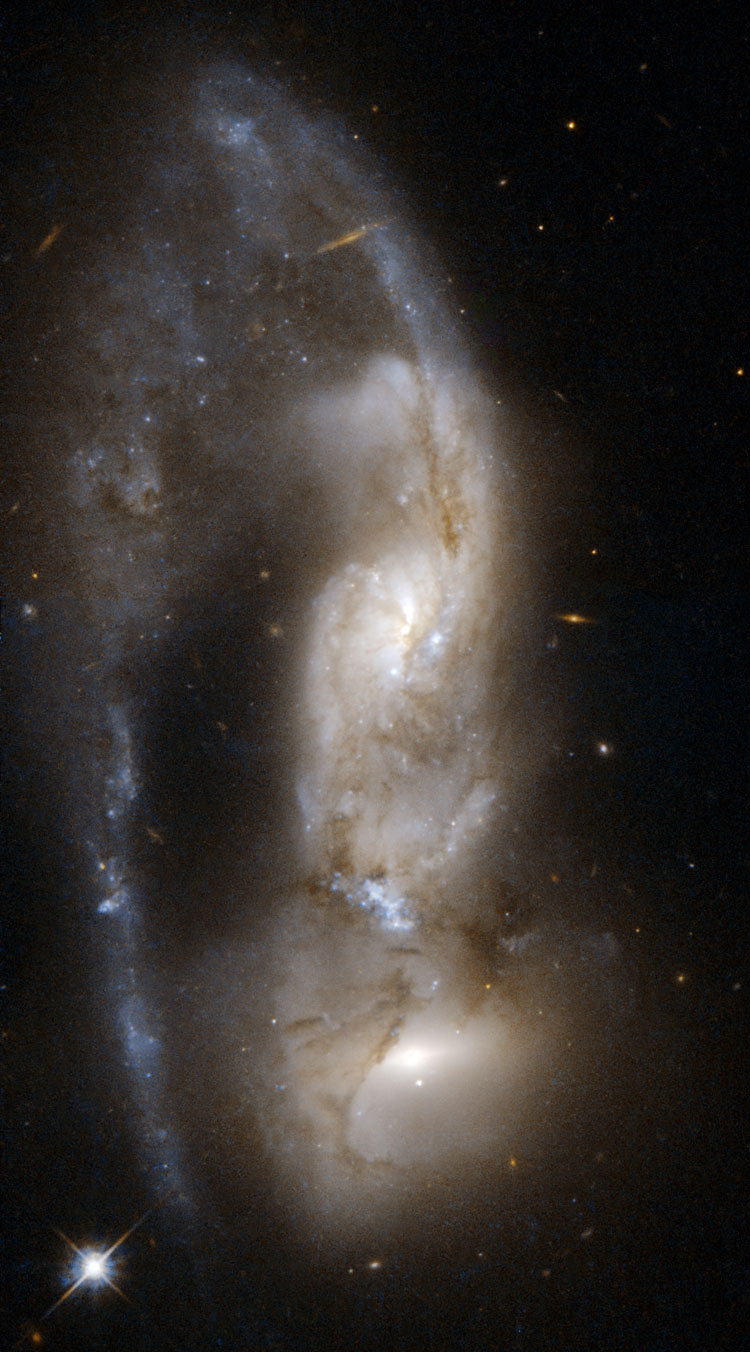
Below, a ? arcmin wide image of Arp 81 (Image Credit Hubble Legacy Archive; processing by Martin Pugh)
NGC 6623
(= GC 5911 = PGC 61739 = UGC 11203 = CGCG 142-040 = MCG +04-43-026)
Discovered (Jun 6, 1864) by Albert Marth
Also observed (Jul 10, 1877) by Édouard Stephan
Also observed (1892) by Hermann Kobold
A magnitude 13.0 elliptical/lenticular galaxy (type E1/SA(l)0- pec) in Hercules (RA 18 19 42.9, Dec +23 42 34)
Historical Identification: Per Dreyer, NGC 6623 (= GC 5911, Marth #377, 1860 RA 18 14 01, NPD 66 22) is "pretty faint, small, round, brighter middle." The NGC position precesses to RA 18 19 49.6, +23 41 27, about 1.9 arcmin southeast of the galaxy listed above, the description fits and there is nothing comparable nearby, so the identification is certain. Its apparent companions (even PGC 61744) are too faint to have been noticed by Marth, so the NGC designation applies only to the brightest galaxy.
Discovery Note: Per Gottlieb, Marth discovered this and NGC 6619 on the same night. He also mentions the observations shown above by Stephan and Kobold (who published an accurate micrometric position in 1907).
NED Confusion: NED lists NGC 6623 as a pair with the galaxy to its south, with a recessional velocity that appears to confirm that. However, LEDA gives very different recessional velocities for the two galaxies, and the pages for NGC 6623 NED 01 and NGC 6623 NED 02 essentially agree with LEDA; so the fainter galaxy is a background galaxy, and not an actual companion, as noted in its entry, below.
Physical Information: LEDA lists a recessional velocity for NGC 6623 of about 4070 km/sec relative to the Cosmic Microwave Background, and NED's entry for NGC 6623 NED02 lists the same value. Based on that (and a Hubble Constant of 70 km/sec/Mpc), NGC 6623 is about 190 million light-years away. Given that and its apparent size of about 1.0 by 0.75 arcmin (from the images below), the galaxy is about 55 thousand light-years across.
Classification Note: The galaxy has a well-defined core, with a very bright central region, and a considerably fainter outer region. Most elliptical galaxies have a smoother brightness gradient, hence my decision to add "pec" to its classification; Corwin essentially agrees, but points out that the "pretty faint corona" is slightly distorted (hence his agreement with "pec"), and sees a "very bright nucleus in a bright lens". The classification shown above is based on his description, and since it places the galaxy between an elliptical (E1) and a lenticular (SA0) galaxy, I have listed it as elliptical/lenticular.

Above, a 12 arcmin wide SDSS/DSS composite image centered on NGC 6623
Below, a 2 arcmin wide SDSS image of the galaxy
Also shown are PGC 61743, PGC 61744, and J181944.8+234259
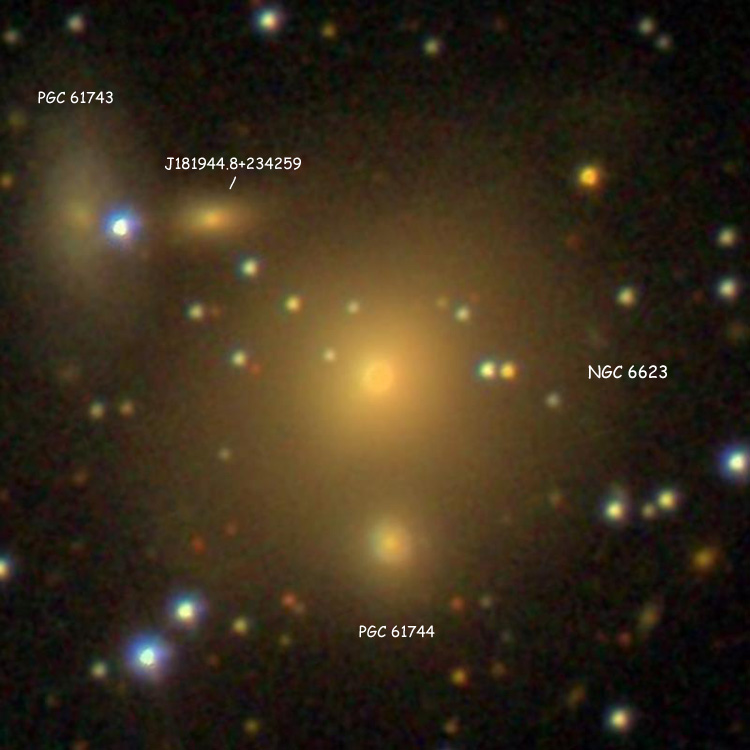
PGC 61743
(= MCG +04-43-028)
Not an NGC object, but listed here as an apparent companion of NGC 6623
A magnitude 16.5(?) spiral galaxy (type SA?cd:) in Hercules (RA 18 19 46.3, Dec +23 43 00)
Physical Information: There appear to be no data that give any suggestion of the distance to this galaxy, so both its physical distance and size are unknown. Therefore also unknown is whether it is a foreground or background galaxy, or an actual companion of NGC 6623. Only the estimated magnitude and its apparent size of about 0.50 by 0.30 arcmin (from the image below) can be stated with some certainty.
Classification Note: Although so faint that it is hard to distinguish its actual nature, Corwin suggests that it has "a pretty faint nucleus in a possible inner ring, with faint arms", which is the basis of the classification shown in the line above.
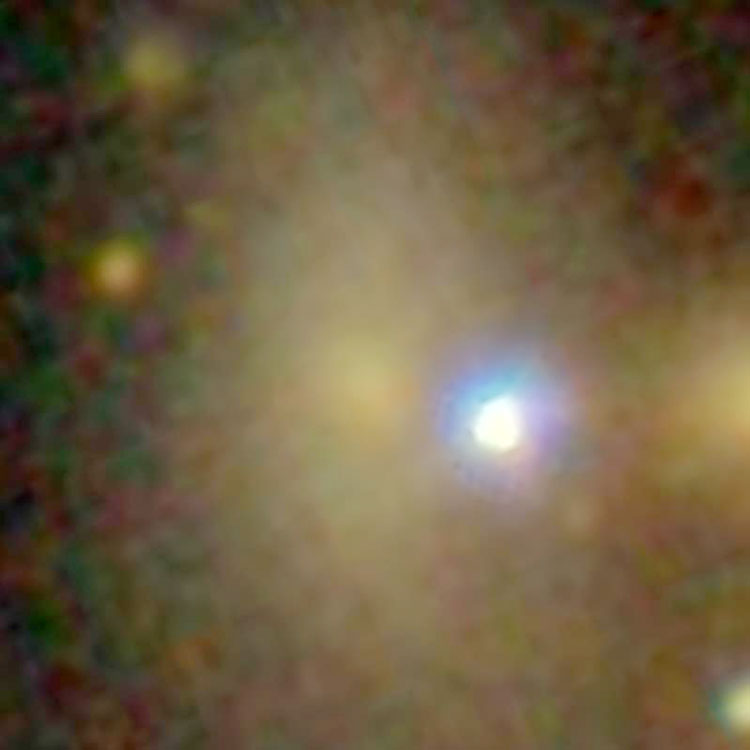
Above, a 0.6 arcmin wide SDSS image of PGC 61743 (see NGC 6623 for wider-field images)
(The fuzz to the right (west) of the galaxy is the outermost part of J181944.8+234259)
PGC 61744
(= MCG +04-43-027)
Not an NGC object, but listed here as an apparent companion of NGC 6623
A magnitude 14.5 lenticular galaxy (type SA:(lr:)00) in Hercules (RA 18 19 42.7, Dec +23 42 07)
Designation Note: Due to a typographical error, earlier versions of Wolfgang Steinicke's NGC/IC database list this as PGC 61749; and although he probably corrected that before you read this, the error may have crept into other databases, which is why it is mentioned here. (It is because of the possibility of one error leading to errors in other places that I encourage readers to let me know if they find any errors in my catalog.)
Note About 'Apparent' Companionship: NED lists NGC 6623 as a pair, and lists a recessional velocity that makes it appear that the two galaxies really ARE a pair. However, LEDA lists a completely different recessional velocity for the brighter galaxy, and a search of NED for NGC 6623 NED 01 and NED 02 (the individual galaxies) agrees with LEDA, meaning that an earlier version of my site which stated that they were probably a pair was a mistake likely to be found in many other places as well. However, as noted here and in the entry for NGC 6623, PGC 61744 is not part of a "pair", but is only a background galaxy.
Physical Information: Based on a recessional velocity of about 4825 km/sec relative to the Cosmic Microwave Background Radiation (for NGC 6623 NED01) and a Hubble Constant of 70 km/sec/Mpc, PGC 61744 is about 225 million light-years away. Given that and its apparent size of about 0.3 by 0.3 arcmin (from the image below, including the galaxy's fainter outer regions), the galaxy is about 20 thousand light-years across.
Classification Note: Per Corwin, PGC 61744 has a small bright nucleus in an elongated lens with a ring and a pretty faint corona. Based on that, he gives the classification shown above.

Above, a 1.0 arcmin wide SDSS image of PGC 61744 and part of NGC 6623, which see for wider views
J181944.8+234259
Not an NGC object, but listed here as an apparent companion of NGC 6623
A magnitude 16.5(?) elliptical galaxy (type E5?) in Hercules (RA 18 19 44.8, Dec +23 42 59)
Physical Information: There appear to be no data that give any suggestion of the distance to this galaxy, so both its physical distance and size are unknown. Therefore also unknown is whether it is a foreground or background galaxy, or an actual companion of NGC 6623. Only the estimated magnitude and its apparent size of about 0.18 by 0.09 arcmin (from the image below) can be stated with some certainty.
Classification Note: Corwin suggests that it is a pretty featureless elliptical galaxy, which is the basis of the classification shown in the line above.
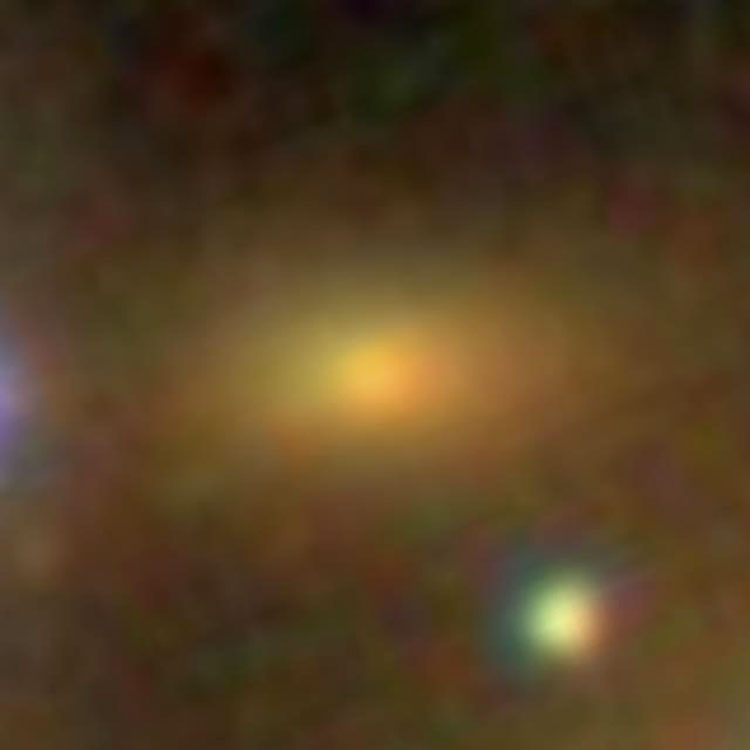
Above, a 0.4 arcmin wide SDSS image of J181944.8+234259 (see NGC 6623 for wider-field images)
NGC 6624 (= GCL 93)
Discovered (Jun 24, 1784) by William Herschel
Also observed (date?) by John Herschel
An 8th-magnitude globular cluster (type VI) in Sagittarius (RA 18 23 40.5, Dec -30 21 38)
Historical Identification: Per Dreyer, NGC 6624 (= GC 4404 = JH 3742 = WH I 50, 1860 RA 18 14 42, NPD 120 25.4) is "a globular cluster, very bright, pretty large, round, well resolved, clearly consisting of stars, stars from 16th magnitude".
Physical Information: Apparent size 8.8? arcmin
NGC 6625 (= OCL 58)
Discovered (Jul 31, 1826) by John Herschel
A 9th-magnitude open cluster in Scutum (RA 18 23 12.8, Dec -12 00 47)
Historical Identification: Per Dreyer, NGC 6625 (= GC 4405 = JH 2009, 1860 RA 18 15 21, NPD 102 06.0) is "a cluster, a little compressed, a little rich, stars from 11th to 12th magnitude".
Physical Information: Apparent size 39? arcmin
NGC 6626 (= M28 = GCL 94)
Discovered (Jul 27, 1764) by Charles Messier (and listed as M28)
Also observed (date?) by John Herschel
A 7th-magnitude globular cluster (type IV) in Sagittarius (RA 18 24 32.9, Dec -24 52 10)
Historical Identification: Per Dreyer, NGC 6626 (= GC 4406 = JH 2010 = JH 3743, M 28, 1860 RA 18 15 56, NPD 114 56.1) is "a remarkable object, a globular cluster, very bright, large, round, gradually an extremely compressed middle, well resolved, clearly consisting of stars, stars from 14th to 16th magnitude".
Physical Information: About 80 light-years across, and 18 thousand light-years away. Apparent size 13.8? arcmin.

Above, a ? arcmin wide image of NGC 6626 (Image Credits: AURA, NSF, NOAO)
Below, a ? arcmin wide view of the cluster
(Image Credit & © Jim Misti, Misti Mountain Observatory; used by permission)

NGC 6627 (= PGC 61792)
Discovered (Jul 13, 1863) by Albert Marth
A 13th-magnitude spiral galaxy (type SBb?) in Hercules (RA 18 22 38.9, Dec +15 41 54)
Historical Identification: Per Dreyer, NGC 6627 (= GC 5912, Marth #378, 1860 RA 18 16 22, NPD 74 23) is "very faint, pretty large".
Physical Information: Apparent size 1.3 by 1.2? arcmin
NGC 6628 (= PGC 61790)
Discovered (Jun 6, 1864) by Albert Marth
A 13th-magnitude lenticular galaxy (type S0?) in Hercules (RA 18 22 21.7, Dec +23 28 39)
Historical Identification: Per Dreyer, NGC 6628 (= GC 5913, Marth #379, 1860 RA 18 16 34, NPD 66 35) is "very faint, small, a little extended, brighter middle".
Physical Information: Apparent size 1.9 by 1.3? arcmin
NGC 6629 (= P-K 009-05.1 = "PGC 3517793")
Discovered (Aug 7, 1784) by William Herschel
Also observed (date?) by John Herschel
An 11th-magnitude planetary nebula in Sagittarius (RA 18 25 42.4, Dec -23 12 08)
Historical Identification: Per Dreyer, NGC 6629 (= GC 4407 = JH 3744 = WH II 204, 1860 RA 18 17 13, NPD 113 16.5) is "a planetary nebula or a globular cluster, pretty bright, most extremely small, round".
PGC Designation Note: For purposes of completeness, LEDA assigned a PGC designation to this object, even though it isn't a galaxy; however, a search of the database for that designation returns no result, so it is shown in quotes.
Physical Information: Apparent size 0.4 by 0.35 arcmin.

Below, a 12 arcmin wide DSS image centered on NGC 6629 (Hubble Legacy Archive image superimposed)
Below, a 2.4 arcmin wide HST/DSS composite image of the planetary nebula
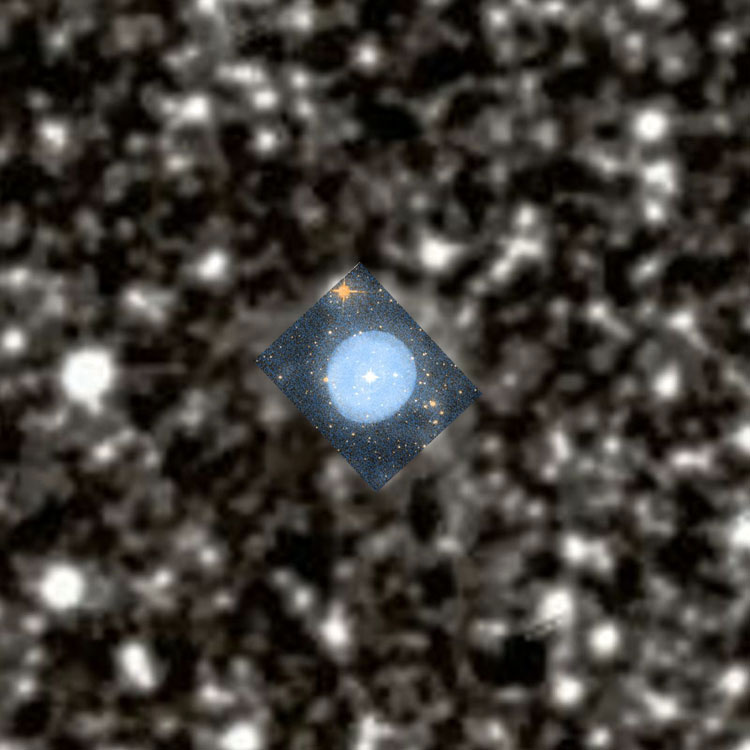
Below, a ? arcmin wide image of the planetary nebula (Image Credit Hubble Legacy Archive)

NGC 6630 (= PGC 62008)
Discovered (Jun 8, 1836) by John Herschel
A 14th-magnitude lenticular galaxy (type E/S0?) in Pavo (RA 18 32 34.5, Dec -63 17 31)
Historical Identification: Per Dreyer, NGC 6630 (= GC 4408 = JH 3745, 1860 RA 18 19 12, NPD 153 22.4) is "pretty faint, small, round, gradually brighter middle".
Physical Information: Apparent size 0.8 by 0.7? arcmin
NGC 6631 (= OCL 59)
Discovered (Jul 12, 1836) by John Herschel
A 12th-magnitude open cluster (type II2m) in Scutum (RA 18 27 09.5, Dec -12 01 35)
Historical Identification: Per Dreyer, NGC 6631 (= GC 4409 = JH 3746, 1860 RA 18 19 23, NPD 102 06.7) is "a cluster, pretty large, pretty rich, stars from 12th to 15th magnitude".
Physical Information: Apparent size 7.0? arcmin
NGC 6632 (= PGC 61849)
Discovered (Jun 24, 1864) by Albert Marth
A 12th-magnitude spiral galaxy (type Sbc?) in Hercules (RA 18 25 03.1, Dec +27 32 09)
Historical Identification: Per Dreyer, NGC 6632 (= GC 5914, Marth #380, 1860 RA 18 19 31, NPD 62 32) is "faint, small, round, gradually brighter middle".
Physical Information: Apparent size 3.0 by 1.4? arcmin
NGC 6633 (= OCL 90)
Discovered (1745) by Phillipe de Cheseaux
Discovered (Jul 31, 1783) by Caroline Herschel
Also observed (Jul 30, 1788) by William Herschel
A 5th-magnitude open cluster in Ophiuchus (RA 18 27 15.1, Dec +06 30 30)
Historical Identification: Per Dreyer, NGC 6633 (= GC 4410 = WH VIII 72, Caroline Herschel, 1860 RA 18 20 43, NPD 83 31.3) is "a cluster, a little compressed, large stars". Although de Chéseaux discovered the cluster in the 1740's, his only publication of his discoveries was a report to the French Academy of Sciences which was more or less forgotten until Guillaume Bigourdan published a note about de Cheseaux in 1892; so Dreyer had no way of knowing that Caroline Herschel was not the first to see the object. The position precesses to RA 18 27 32.0, Dec +06 33 37, about 3 arcmin northeast of the position listed above, but well within the boundary of the cluster and the description fits, so the identification is certain.
Physical Information: The cluster contains a couple of dozen relatively bright stars scattered across an irregularly shaped 20 to 30 arcmin wide field, the brightest being about magnitude 7 1/2. At the cluster's estimated distance of a thousand light-years, its apparent size corresponds to about 8 light-years. Based on the spectral types of its Main Sequence stars, NGC 6633's age is estimated at six to seven hundred million years.

Above, a 45 arcmin wide DSS image centered on NGC 6633
Below, a 30 arcmin wide DSS image of the cluster
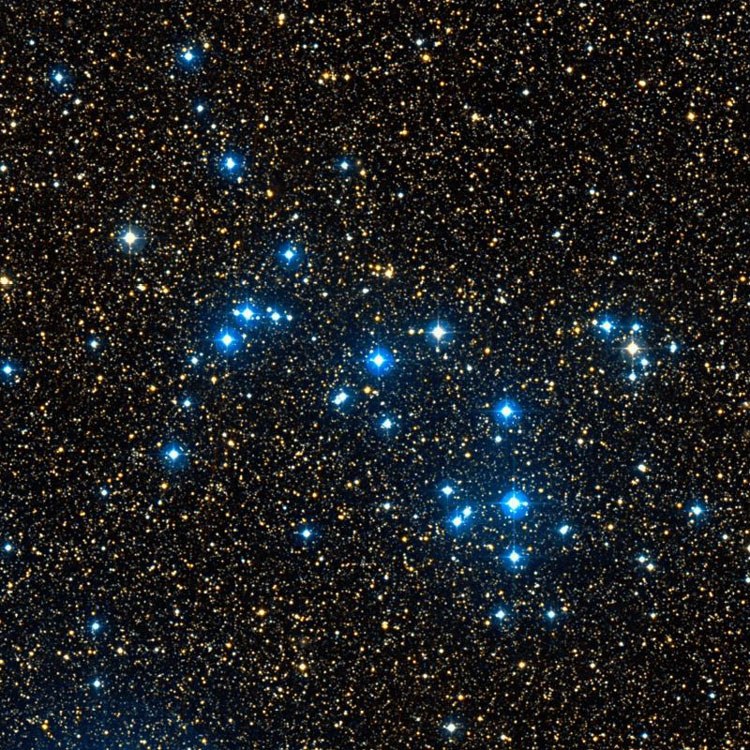
NGC 6634
Discovered (1751) by Nicolas Lacaille
A group of stars in Sagittarius (RA 18 29 55.3, Dec -33 30 40)
Historical Identification: Per Dreyer, NGC 6634 (= GC 5076, Lacaille list I 11, 1860 RA 18 20 45, NPD 123 30.5) is "a nebula, without stars". The object is now identified as a group of stars without nebulosity, showing the difficulty of determining the nature of faint fuzzy objects with visual observations through a small telescope. (Steinicke notes "not M69". This refers to the fact that Messier was looking for Lacaille's nebula when he found M69, and thought he had rediscovered the same object, as M69 looks nebular in a small telescope; but they are not the same object at all.) The position precesses to RA 18 29 58.2, Dec -33 25 20, about 5 arcmin north of the listed position; but there is nothing else nearby, so the identification is reasonably certain.
Physical Information: NGC 6634 consists of less than half a dozen stars ranging from 7th to 9th magnitude, and would have hardly seemed worth mentioning if its true nature had been more readily apparent to Lacaille.

Above, a 15 arcmin wide DSS image centered on NGC 6634
NGC 6635 (= PGC 61900)
Discovered (Jul 9, 1863) by Albert Marth
A 13th-magnitude lenticular galaxy (type S0?) in Hercules (RA 18 27 37.0, Dec +14 49 07)
Historical Identification: Per Dreyer, NGC 6635 (= GC 5915, Marth #381, 1860 RA 18 21 15, NPD 75 18) is "very faint, small, round".
Physical Information: Apparent size 1.0 by 0.9? arcmin
NGC 6636 (= PGC 61782 (+ PGC 61780?))
Discovered (Jul 23, 1884) by Lewis Swift
A pair of spiral galaxies in Draco
PGC 61782: A 14th-magnitude spiral galaxy (type Sc?) at RA 18 22 02.6, Dec +66 37 03
PGC 61780: A 15th-magnitude spiral galaxy (type Sab?) at RA 18 22 04.9, Dec +66 37 21
Historical Identification: Per Dreyer, NGC 6636 (Swift list IV (#68), 1860 RA 18 22 00, NPD 23 27.4) is "most extremely faint, pretty small, round, 3 stars near".
Physical Information: PGC 61782: Apparent size 2.1 by 0.3? arcmin. PGC 61780: Apparent size 0.3 by 0.3? arcmin.
PGC 61780 recessional velocity = 4655 km/sec. PGC 61782 recessional velocity = 4393 km/sec. The difference is within the normal range of peculiar (non-Hubble expansion) velocities, so the galaxies are probably a physical pair. PGC 61780 is much smaller and fainter than PGC 61782, so its existence had little if anything to do with Swift's observation; but since it is a physical pair with the larger galaxy, it is often listed as if a part of NGC 6636.

Above, a 12 arcmin DSS image centered on NGC 6636 and its companion, PGC 61780
Below, a 2.4 arcmin wide DSS image of the pair

NGC 6637 (= M69 = GCL 96)
Discovered (Aug 31, 1780) by Charles Messier (and listed as M69)
Also observed (date?) by James Dunlop
An 8th-magnitude globular cluster (type V) in Sagittarius (RA 18 31 23.2, Dec -32 20 51)
Historical Identification: Per Dreyer, NGC 6637 (= GC 4411, M 69, Dunlop 613, 1860 RA 18 22 13, NPD 122 26.6) is "a globular cluster, bright, large, round, well resolved, clearly consisting of stars, stars from 14th to 16th magnitude".
Physical Information: M69 is about 30 thousand light-years away. Given that, its 7.1 arcmin apparent size corresponds to about 50 light-years. It is said to be one of the most metal-rich of all globular clusters, suggesting a slightly younger age than is typical for such ancient objects; but its stars still have far fewer "metal" atoms (that is, atoms other than hydrogen and helium) than much younger stars like our Sun.

Above, a 12 arcmin wide image centered on NGC 6637 (Composite of the NOAO image below, and a DSS image)
Below, a roughly 6 arcmin wide image of the cluster (Image Credits: REU program, AURA, NSF, NOAO)

Below, a 3.5 arcmin wide detail of the cluster's core (Image Credit ESA/HST (Wikisky cutout))

NGC 6638
(= GCL 95 = ESO 522-SC030 = "PGC 3517744")
Discovered (Jul 12, 1784) by William Herschel
Also observed (Jul 29, 1834) by John Herschel
A magnitude 8.9 globular cluster (type VI) in Sagittarius (RA 18 30 56.2, Dec -25 29 50)
Historical Identification: Per Dreyer, NGC 6638 (= GC 4412 = JH 3748 = WH I 51, 1860 RA 18 22 17, NPD 115 35.2) is "a globular cluster, bright, small, round, partially resolved (some stars seen)." The position precesses to RA 18 30 56.1, Dec -25 29 47, nearly dead center on the cluster listed above, the description fits and there is nothing else nearby, so the identification is certain.
Note About PGC Designation: As is usual for NGC/IC objects, HyperLEDA assigned a PGC designation to this object even though it isn't a galaxy; but as is also usual in such situations a search of the database for that designation doesn't return a result, so it is shown in quotes.
Physical Information: NGC 6638 is thought to be about 30 to 34 thousand light-years from the Sun, and about 7 to 8 thousand light-years from the center of our galaxy. Its central region has an apparent size of just under 3 arcmin (from the images below), but there is an excess of faint stars presumably representing the outer part of the cluster with an apparent size of about 7 arcmin. Given the distance from the Sun, the bright central region would then be about 25 to 30 light-years in diameter, while the outer parts of the cluster would fill a region a little more than half the size of the wide-field image below, or about 65 light-years. Per Baumgardt, the cluster has a mass of about 120 thousand Solar masses, but like all clusters of its age (about 12 billion years) most of its stars are considerably less massive than the Sun, so there are probably over 200 thousand stars within its boundary. Half the mass of the cluster is thought to lie within a region about 15 light-years across, or roughly the inner 1.5 arcmin of the cluster (shown in the HST "closeup" image), while the rest of the mass/(stars) is/(are) scattered throughout the outer 5.5 or so arcmin.
Orbital calculations based on its present distance and proper motion suggest that the cluster orbits our galaxy about once every 25 to 30 million years, with a very eccentric orbit that (like most orbits of globular clusters that pass near the center of the galaxy) rotates around the galaxy a bit after each pass near its center. Perigalaxion is usually in the range of 500 to 1500 light-years (very close to the center), while apogalaxion is close to 8000 light-years. At the moment it is near apogalaxion, headed outward, so within a few million years it will reach its greatest distane from the center of the galaxy and start falling back toward the center. Many globular clusters that pass so close to the center of the galaxy have orbits that stick pretty close to the plane of the galactic disk, but NGC 6638's apogalaxion sometimes lies as much as 40 degrees above or below the galactic plane, and a plot of numerous calculated orbits shows orbital inclinations pretty randomly scattered between those extremes.

Above, a 12 arcmin wide PanSTARRS image centered on NGC 6638
The outer parts of the cluster aren't obvious given the stellar background, but span a little over 7 arcmin
Below, a 5 arcmin wide PanSTARRS image of most of the cluster

Below, a 3 arcmin wide HST/PanSTARRS composite image of the central part of the cluster
(Image Credit ESA/Hubble & NASA, R. Cohen)

Below, a 1.5 arcmin wide HST image of the central part of the globular cluster (Image Credit as above)
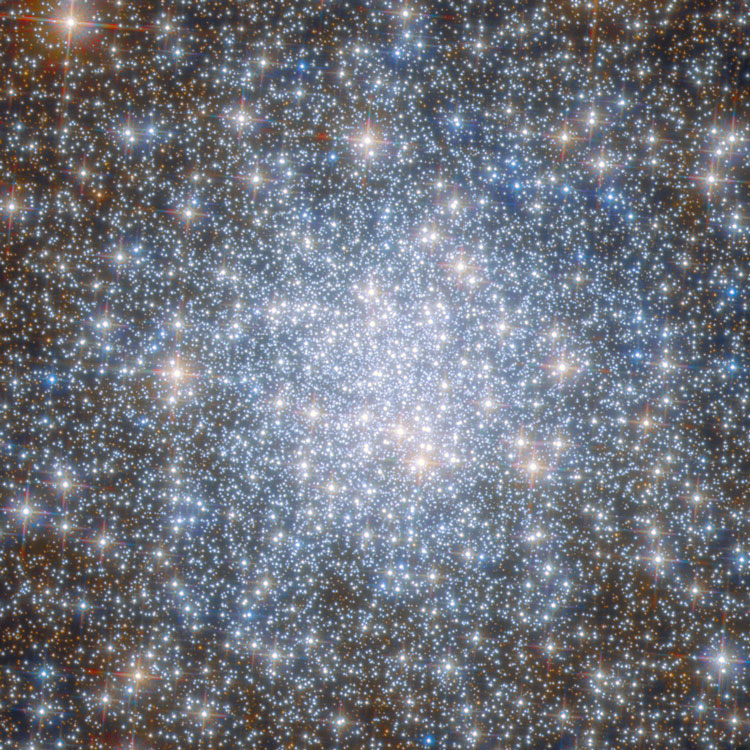
NGC 6639 (= OCL 57)
Discovered (Jul 31, 1826) by John Herschel
An open cluster in Scutum (RA 18 30 57.8, Dec -13 10 14)
Historical Identification: Per Dreyer, NGC 6639 (= GC 4413 = JH 2011, 1860 RA 18 23 05, NPD 103 15.2) is "a cluster (in the Milky Way)".
Physical Information: Apparent size 5.0? arcmin
NGC 6640 (= PGC 61913)
Discovered (Aug 21, 1884) by Édouard Stephan
A 14th-magnitude spiral galaxy (type Sc?) in Lyra (RA 18 28 08.1, Dec +34 18 09)
Historical Identification: Per Dreyer, NGC 6640 (Stephan list XIII (#89), 1860 RA 18 23 05, NPD 55 47.2) is "very faint, small, round, very little brighter middle".
Physical Information: Apparent size 1.1 by 0.8? arcmin
WORKING HERE
NGC 6641 (= PGC 61935)
Discovered (Aug 9, 1866) by Truman Safford
Discovered (date?) by Édouard Stephan
A 13th-magnitude spiral galaxy (type S??) in Hercules (RA 18 28 57.3, Dec +22 54 12)
Historical Identification: Per Dreyer, NGC 6641 (= GC 5916, Stephan list V (#??), (Safford 47), 1860 RA 18 23 06, NPD 67 10.8) is "very faint, very small, round, brighter middle".
Discovery Notes: Safford's observations weren't published until Dreyer was preparing the NGC for final publication, so he only noted them in an appendix and did not mention them in any of the NGC entries; hence the inclusion of Safford's credit in parentheses.
Physical Information: Apparent size 0.9 by 0.7? arcmin
Various recent infrared measurements of RR Lyrae stars (to reduce the influence of reddening by interstellar dust) indicate a distance modulus of 15.6 magnitudes, give or take about 0.07 magnitudes, or about 42.5 thousand light-years, give or take a thousand or two light-years' uncertainty. Given that and the apparent size of the cluster (about ? arcmin, from the images below and other measurements), the physical size of the cluster is about ? light-years.
NGC 6642 (= GCL 97)
Discovered (Aug 7, 1784) by William Herschel
Also observed (date?) by John Herschel
A 9th-magnitude globular cluster (type IV) in Sagittarius (RA 18 31 54.3, Dec -23 28 33)
Historical Identification: Per Dreyer, NGC 6642 (= GC 4414 = JH 2012 = JH 5749 = WH II 205, 1860 RA 18 23 23, NPD 113 34.0) is "a globular cluster, pretty bright, pretty large, irregularly round, gradually pretty much brighter middle, well resolved, clearly consisting of stars, stars of 16th magnitude".
Physical Information: Apparent size 5.8? arcmin
NGC 6643 (= PGC 61742)
Discovered (1858) by Eduard Schönfeld (BD +74 766)
Discovered (Sep 1, 1859) by Horace Tuttle
Also observed? (date?) by Arthur von Auwers
An 11th-magnitude spiral galaxy (type Sc?) in Draco (RA 18 19 45.6, Dec +74 34 06)
Historical Identification: Per Dreyer, NGC 6643 (= GC 4415, Tuttle, 1860 RA 18 23 47, NPD 15 30.3) is "pretty bright, pretty large, extended 50°, 2 stars to west (Auwers 40)".
Physical Information: Apparent size 3.7 by 1.8? arcmin
NGC 6644 (= P-K 008-07.2 = "PGC 3517794")
Discovered (Jul 13, 1880) by Edward Pickering
An 11th-magnitude planetary nebula in Sagittarius (RA 18 32 34.7, Dec -25 07 42)
Historical Identification: Per Dreyer, NGC 6644 (Pickering (HN ??), 1860 RA 18 23 56, NPD 115 14) is "a planetary nebula, stellar".
PGC Designation Note: For purposes of completeness, LEDA assigned a PGC designation to this object, even though it isn't a galaxy; however, a search of the database for that designation returns no result, so it is shown in quotes.
Physical Information: Apparent size 0.2? arcmin
NGC 6645 (= OCL 48)
Discovered (Jun 27, 1786) by William Herschel
Also observed (date?) by John Herschel
A 9th-magnitude open cluster (type III1m) in Sagittarius (RA 18 32 37.8, Dec -16 53 02)
Historical Identification: Per Dreyer, NGC 6645 (= GC 4416 = JH 2013 = WH VI 23, 1860 RA 18 24 32, NPD 106 59.1) is "a cluster, pretty large, very rich, pretty compressed, stars from 11th to 15th magnitude".
Physical Information: Apparent size 15? arcmin
NGC 6646 (= PGC 61944)
Discovered (Jun 26, 1802) by William Herschel
A 13th-magnitude spiral galaxy (type Sa?) in Lyra (RA 18 29 38.7, Dec +39 51 54)
Historical Identification: Per Dreyer, NGC 6646 (= GC 4417 = WH II 907, 1860 RA 18 25 03, NPD 50 13.7) is "faint, small, irregular figure".
Physical Information: Apparent size 1.6 by 1.3? arcmin
NGC 6647
Discovered (Jun 18, 1784) by William Herschel
Also observed (date?) by John Herschel
A 7th-magnitude open cluster in Sagittarius (RA 18 32 49.0, Dec -17 13 42)
Historical Identification: Per Dreyer, NGC 6647 (= GC 4418 = JH 2014 = WH VIII 14, 1860 RA 18 25 05, NPD 107 26.0) is "a cluster, large, rich, a little compressed, stars very small".
Physical Information:
NGC 6648
Recorded (1825) by Wilhelm Struve
Also observed? (date?) by Arthur von Auwers
A pair of stars in Draco (RA 18 25 37.4, Dec +64 58 33)
Historical Identification: Per Dreyer, NGC 6648 (= GC 4419, Struve 7, 1860 RA 18 25 05, NPD 25 05.7) is "small, pretty much extended, double star involved (Auwers 41)".
NGC 6649 (= OCL 66)
Discovered (Jul 10, 1787) by William Herschel
Discovered (May 27, 1835) by John Herschel
A 9th-magnitude open cluster (type II2m) in Scutum (RA 18 33 28.3, Dec -10 24 08)
Historical Identification: Per Dreyer, NGC 6649 (= GC 4420 = JH 3751, 1860 RA 18 25 44, NPD 100 29.5) is "a cluster, poor, a little compressed, pretty small, stars of 9th or 10th and from 12th to 13th magnitude".
Discovery Notes: William Herschel's observation was unknown until Steinicke completed a study of Herschel's papers, so John Herschel is usually listed as the discoverer of this object (as shown in the NGC entry), and in any event his observation was an independent discovery.
Physical Information: Apparent size 6.0? arcmin.

Above, a 20 arcmin wide DSS image centered on NGC 6649
Below, a 12 arcmin wide DSS image of the cluster

|